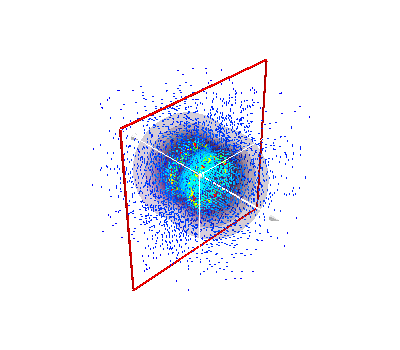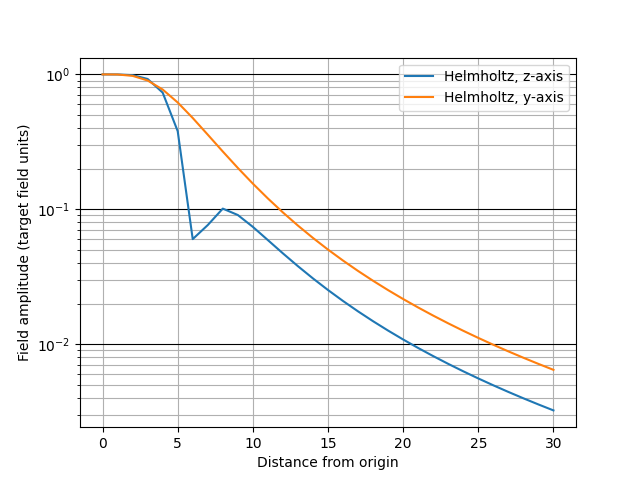Note
Click here to download the full example code
Field of a Helmholtz coils pair¶
Example on how to compute the magnetic field from current line segments forming a Helmholtz coil pair.
Visualization of the 3D field using Mayavi
from mayavi import mlab
import matplotlib.pyplot as plt
import numpy as np
from bfieldtools.utils import cylinder_points
from bfieldtools.line_magnetics import magnetic_field
# Create helmholtz coil with radius R
R = 5
c_points = cylinder_points(
radius=R, length=0, nlength=1, nalpha=100, orientation=np.array([0, 1, 0])
)
c_points[:, 1] = 0
c_points = np.vstack((c_points, c_points[0, :]))
c1_points = c_points - np.array([0, R / 2, 0])
c2_points = c_points + np.array([0, R / 2, 0])
mlab.figure(bgcolor=(1, 1, 1))
mlab.plot3d(*c1_points.T)
mlab.plot3d(*c2_points.T)
box = 3 * R
n = 50
xx = np.linspace(-box, box, n)
yy = np.linspace(-box, box, n)
zz = np.linspace(-box, box, n)
X, Y, Z = np.meshgrid(xx, yy, zz, indexing="ij")
x = X.ravel()
y = Y.ravel()
z = Z.ravel()
b_points = np.array([x, y, z]).T
B = np.zeros(b_points.shape)
B += magnetic_field(c1_points, b_points)
B += magnetic_field(c2_points, b_points)
B_matrix = B.reshape((n, n, n, 3))
B_matrix_norm = np.linalg.norm(B_matrix, axis=-1)

mlab.figure(bgcolor=(1, 1, 1))
field = mlab.pipeline.vector_field(
X,
Y,
Z,
B_matrix[:, :, :, 0],
B_matrix[:, :, :, 1],
B_matrix[:, :, :, 2],
scalars=B_matrix_norm,
name="B-field",
)
vectors = mlab.pipeline.vectors(field, scale_factor=(X[1, 0, 0] - X[0, 0, 0]),)
vectors.glyph.mask_input_points = True
vectors.glyph.mask_points.on_ratio = 2
vcp = mlab.pipeline.vector_cut_plane(field)
vcp.glyph.glyph.scale_factor = 10 * (X[1, 0, 0] - X[0, 0, 0])
# For prettier picture:
vcp.implicit_plane.widget.enabled = True
iso = mlab.pipeline.iso_surface(field, contours=10, opacity=0.2, colormap="viridis")
# A trick to make transparency look better: cull the front face
iso.actor.property.frontface_culling = True
# Settings
iso.contour.maximum_contour = 1e-07
vcp.implicit_plane.widget.normal_to_y_axis = True

plt.figure()
z1 = np.linspace(0, 30, 31)
x1 = y1 = np.zeros_like(z1)
line1_points = np.vstack((x1, y1, z1)).T
Bh_line1 = magnetic_field(c1_points, line1_points) + magnetic_field(
c2_points, line1_points
)
plt.semilogy(
z1,
np.linalg.norm(Bh_line1, axis=1) / np.linalg.norm(Bh_line1, axis=1)[0],
label="Helmholtz, z-axis",
)
y2 = np.linspace(0, 30, 31)
z2 = x2 = np.zeros_like(y2)
line2_points = np.vstack((x2, y2, z2)).T
Bh_line2 = magnetic_field(c1_points, line2_points) + magnetic_field(
c2_points, line2_points
)
plt.semilogy(
y2,
np.linalg.norm(Bh_line2, axis=1) / np.linalg.norm(Bh_line2, axis=1)[0],
label="Helmholtz, y-axis",
)
plt.ylabel("Field amplitude (target field units)")
plt.xlabel("Distance from origin")
plt.grid(True, which="minor", axis="y")
plt.grid(True, which="major", axis="y", color="k")
plt.grid(True, which="major", axis="x")
plt.legend()

Out:
<matplotlib.legend.Legend object at 0x7fc4c85c6650>
Total running time of the script: ( 0 minutes 3.389 seconds)
Estimated memory usage: 65 MB
